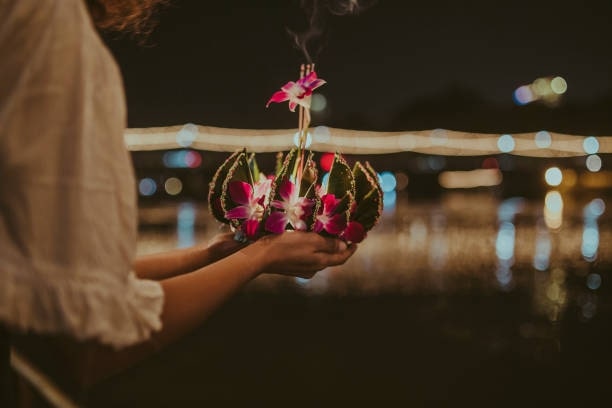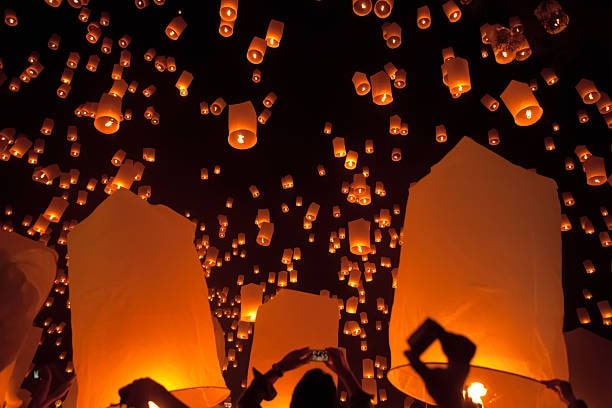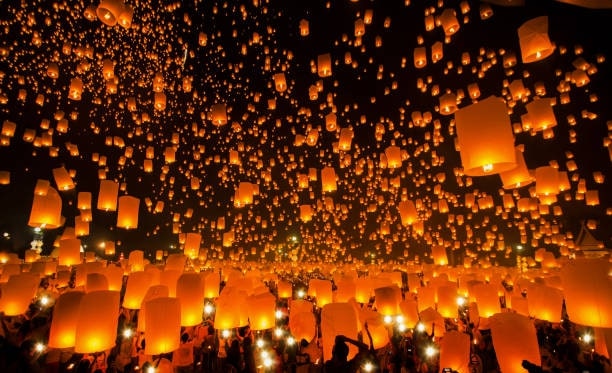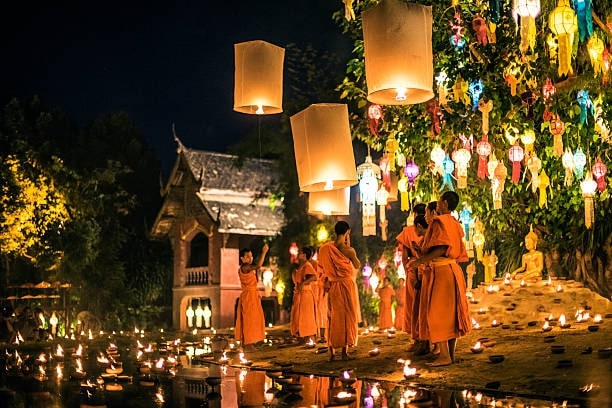Categories > Guides and Tips

History of Thai Lantern Festivals: Loy Krathong and Yi Peng
Every year, Thailand hosts two extraordinary lantern festivals, Loy Krathong and Yi Peng. Picture this: thousands of delicate, flickering lights casting their ethereal glow upon the waters and the night sky.
Loy Krathong and Yi Peng are captivating traditions steeped in history. Loy Krathong floats lanterns on water, symbolising renewal and letting go of negativity.
Yi Peng releases sky lanterns, marking gratitude and seeking good fortune. A mesmerising blend of culture and spirituality.
From ancient rituals to modern-day celebrations, they’ve become a time for the Thai people to gather, show gratitude, and release their worries into the world with floating krathongs and soaring lanterns.
So, grab a virtual lantern, and let’s journey back through time to discover the captivating tales and customs that make Loy Krathong and Yi Peng an experience you’ll never forget!
Loy Krathong Festival

The Loy Krathong Festival, one of Thailand’s most enchanting celebrations, has a fascinating history that dates back centuries.
Rooted in the ancient Sukhothai period (1238-1438), the origins of this festival can be traced to a beautiful blend of Hindu and Buddhist traditions.
During the Sukhothai era, the festival began as a Brahmanic ritual to pay homage to the water goddess, Mae Kongka. The people would create small lotus-shaped vessels, known as krathongs, made from banana leaves, flowers, candles, and incense.
These krathongs were set afloat on water bodies, symbolising gratitude to the river goddess and seeking her forgiveness for any pollution caused throughout the year.
As time passed, Loy Krathong merged with local beliefs and customs, becoming an integral part of Thailand’s cultural identity. It evolved to include prayers for good fortune, prosperity, and the opportunity to start anew.
This Thai lantern festival became not only a religious observance but also a time for people to come together, celebrate their bond with water and nature, and express their hopes and dreams for the future.
Today, Loy Krathong is celebrated throughout Thailand with great enthusiasm and joy.
The tradition of releasing krathongs on rivers, canals, and lakes continues to be a symbol of appreciation for nature’s abundance and an opportunity to cleanse the soul by letting go of negativity.
Interesting Facts about Loy Krathong

A Fusion Fiesta: Loy Krathong is like a party where Hindu and Buddhist traditions come together, symbolising gratitude, apologies, and hopes for a brighter tomorrow.
Love is in the Air: Couples get all lovey-dovey during the festival, releasing krathongs side by side to show their undying affection and unity.
Environmental Awareness: In recent years, eco-friendly krathongs made from biodegradable materials have gained popularity to protect waterways.
Full Moon Affair: Loy Krathong takes place on the full moon night of the twelfth lunar month (usually in November), adding to the mystical ambiance.
Floating Wishes: As the krathongs drift away, people believe their troubles and negative energies are carried away, granting them a fresh start.
Yi Peng Lantern Festival

The Yi Peng Lantern Festival, an awe-inspiring event in Thailand, traces its roots back to the ancient Lanna Kingdom, which flourished in the northern region of the country.
With its origins deeply steeped in spiritual practices, this captivating festival has a history spanning several centuries.
The Lanna Kingdom, known for its unique cultural identity, held the Yi Peng Festival as a time to pay homage to Lord Buddha.
Itl coincided with the end of the rainy season, during the 12th month of the Lanna lunar calendar. People would gather to release beautifully crafted sky lanterns, or khom loi, into the night sky as a symbol of reverence and gratitude.
The release of these sky lanterns was believed to bring good fortune and prosperity, as well as to dispel bad luck and misfortunes.
As the lanterns floated skyward, the act was seen as a way to let go of worries and negative energies, embracing a fresh start and a brighter future.
While the historical significance of the Yi Peng Festival remains firmly rooted in the Lanna Kingdom, today, it has grown into a grand celebration, attracting people from all over the world.
The sight of countless lanterns ascending into the night sky in a synchronised dance creates a breathtaking spectacle, infusing the atmosphere with a sense of wonder and spiritual reflection.
In particular, the city of Chiang Mai has become synonymous with the Yi Peng Lantern Festival, drawing large crowds of locals and tourists alike.
During this time, the city is adorned with lanterns and decorations, and the festivities are amplified with cultural performances, parades, and a sense of joyous camaraderie.
Interesting Facts about Yi Peng Lantern Festival

Skyward Dreams: During Yi Peng, thousands of glowing lanterns ascend into the heavens, creating a breathtaking spectacle that fills the heart with wonder.
Lanna Heritage: The festival’s connection to the Lanna Kingdom showcases the deep-rooted cultural heritage of northern Thailand.
Spiritual Reflection: Releasing sky lanterns is considered an act of letting go of negativity and seeking blessings for a brighter future.
Synchronised Launch: The sight of countless lanterns rising together is a testament to the unity and shared aspirations of the festival’s participants.
Floating Loy Krathong: In Chiang Mai, Yi Peng coincides with Loy Krathong, resulting in a captivating combination of floating river lanterns and sky lanterns, enhancing the enchantment of the festivities.
Loy Krathong vs. Yi Peng: What are their differences?

| Loy Krathong | Yi Peng Lantern Festival | |
| Origin | Originated during the Sukhothai period as a Brahmanic ritual to honour the river goddess. | Emerged from the ancient Lanna Kingdom’s spiritual practice to ward off misfortune and welcome prosperity. |
| Lanterns | Floats small, beautifully decorated krathongs (floating baskets) on water bodies. | Releases sky lanterns that soar into the night sky, illuminating it with a mesmerising display. |
| Location | Celebrated throughout Thailand on water bodies like rivers, canals, and lakes. | Primarily observed in northern Thailand, particularly in Chiang Mai. |
| Significance | Symbolises gratitude, apologies, and hopes for a better future. | Represents letting go of negativity and seeking blessings for a prosperous life. |
| Timing | Held on the full moon night of the twelfth lunar month (usually in November). | Coincides with the Yi Peng Festival on the same full moon night in northern Thailand. |





